- Regulatory Status
- RUO
- Other Names
- IL-32 alpha, Natural killer cells protein 4 (NK4), Natural killer transcript 4 (NK4), Tumor necrosis factor alpha-inducing factor (TAIF)
- Ave. Rating
- Submit a Review
- Product Citations
- 2 publications
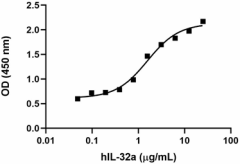
| Cat # | Size | Price | Save |
|---|---|---|---|
| 551002 | 10 µg | ¥24,680 | |
| 551004 | 25 µg | ¥41,000 |
IL-32 is a proinflammatory cytokine with both extracellular and intracellular functions. IL-32 was originally identified as a natural killer transcript 4 (NK4). Several isoforms of IL-32 have been identified, and IL-32α is the most abundant. Overexpression of IL-32α in myeloid cell lines enhances natural killer cell-mediated killing, and IL-32 expression can be induced by IL-18 in NK cells. IL-32α can be released by some epithelial cell lines in response to INF-γ, TNF-α, and IL-1β. IL-32 can induce production of various cytokines including TNF-α, IL-1β, IL-8 and IL-6 through NF-κB and p38 MAPK activation. IL-32 works synergistically with IL-17 to induce osteoclast differentiation. Recombinant IL-32α can induce macrophage apoptosis in the presence of M. tuberculosis. Intracellular IL-32α increases IL-6 production by interacting with PKCε and STAT3, which not only increases STAT3 phosphorylation but also enhances STAT3 recruitment to the IL-6 promoter. IL-32 can synergize with NOD1 and NOD2 ligands to induce IL-1β and IL-6 through the caspase I-dependent pathway. IL-32 has been associated with pathogenesis of many chronic inflammatory diseases including rheumatoid arthritis and ulcerative colitis. IL-32 is highly expressed in various cancers including gastric and pancreatic cancer. Studies have suggested that IL-32 can function as an angiogenic factor. In addition, IL-32α expression in liver cells is increased following progression of many liver diseases. Also, IL-32 is involved in the immune response to many viruses including HIV, influenza A, hepatitis B, and papillomavirus.
Product DetailsProduct Details
- Source
- Human IL-32α, amino acids Cys2-Lys131 (Accession# NP_001012651.1) with an additional N-terminal Met, was expressed in E. coli.
- Molecular Mass
- The 131 amino acid recombinant protein has a predicted molecular mass of approximately 14.9 kD. The DTT-reduced and non-reduced protein migrates at approximately 20 kD by SDS-PAGE. The predicted N-terminal amino acid is Methione.
- Purity
- >90 %, as determined by Coomassie stained SDS-PAGE.
- Formulation
- 0.22 µm filtered protein solution is in PBS, pH 7.4, with 10 mM DTT.
- Endotoxin Level
- Less than 0.01 ng per µg cytokine as determined by the LAL method.
- Concentration
- 10 and 25 µg sizes are bottled at 200 µg/mL. 100 µg size and larger sizes are lot-specific and bottled at the concentration indicated on the vial. To obtain lot-specific concentration and expiration, please enter the lot number in our Certificate of Analysis online tool.
- Storage & Handling
- Unopened vial can be stored between 2°C and 8°C for up to 2 weeks, at -20°C for up to six months, or at -70°C or colder until the expiration date. For maximum results, quick spin vial prior to opening. The protein can be aliquoted and stored at -20°C or colder. Stock solutions can also be prepared at 50 - 100 µg/mL in appropriate sterile buffer, carrier protein such as 0.2 - 1% BSA or HSA can be added when preparing the stock solution. Aliquots can be stored between 2°C and 8°C for up to one week and stored at -20°C or colder for up to 3 months. Avoid repeated freeze/thaw cycles.
- Activity
- Human IL-32α induces TNFα in mouse RAW 264.7 cells treated with muramyl dipeptide (MDP) solution in a dose-dependent manner. The ED50 for this effect is 0.8 to 3.2 µg/mL.
- Application
-
Bioassay
- Application Notes
-
BioLegend carrier-free recombinant proteins provided in liquid format are shipped on blue-ice. Our comparison testing data indicates that when handled and stored as recommended, the liquid format has equal or better stability and shelf-life compared to commercially available lyophilized proteins after reconstitution. Our liquid proteins are verified in-house to maintain activity after shipping on blue ice and are backed by our 100% satisfaction guarantee. If you have any concerns, contact us at tech@biolegend.com.
- Product Citations
-
Antigen Details
- Structure
- Cytokine
- Distribution
-
IL-32α can be produced by T cells, natural killer cells, dendritic cells, and keratinocytes.
- Function
- IL-32α expression can be induced by IL-18, IL-1β, IFN-γ, IL-12 and IL-17. The activity of IL-32α can be significantly increased by limited cleavage of IL-32α by neutrophil proteinase 3.
- Interaction
- IL-32α has been reported to interact with neutrophil proteinase 3, PKC, STAT3, integrin and paxilin.
- Biology Area
- Immunology, Stem Cells
- Molecular Family
- Cytokines/Chemokines
- Antigen References
-
1. Joosten LA, et al. 2013. Cell Mol. Life Sci. 70:3883.
2. Kang JW, et al. 2012. J. Biol. Chem. 287:35556.
3. Cheon S, et al. 2011. J. Biol. Chem. 286:12049.
4. Nishida A, et al. 2009. J. Biol. Chem. 284:17868.
5. Heinhuis B, et al. 2012. J. Biol. Chem. 287:5733.
6. Novick D, et al. 2006. Proc. Natl. Acad. Sci. 103:3316.
7. Shioya M, et al. 2007. Clin. Exp. Immunol. 149:480. - Gene ID
- 9235 View all products for this Gene ID
- UniProt
- View information about IL-32alpha on UniProt.org
Related Pages & Pathways
Pages
Related FAQs
- Why choose BioLegend recombinant proteins?
-
• Each lot of product is quality-tested for bioactivity as indicated on the data sheet.
• Greater than 95% Purity or higher, tested on every lot of product.
• 100% Satisfaction Guarantee for quality performance, stability, and consistency.
• Ready-to-use liquid format saves time and reduces challenges associated with reconstitution.
• Bulk and customization available. Contact us.
• Learn more about our Recombinant Proteins. - How does the activity of your recombinant proteins compare to competitors?
-
We quality control each and every lot of recombinant protein. Not only do we check its bioactivity, but we also compare it against other commercially available recombinant proteins. We make sure each recombinant protein’s activity is at least as good as or better than the competition’s. In order to provide you with the best possible product, we ensure that our testing process is rigorous and thorough. If you’re curious and eager to make the switch to BioLegend recombinants, contact your sales representative today!
- What is the specific activity or ED50 of my recombinant protein?
-
The specific activity range of the protein is indicated on the product datasheets. Because the exact activity values on a per unit basis can largely fluctuate depending on a number of factors, including the nature of the assay, cell density, age of cells/passage number, culture media used, and end user technique, the specific activity is best defined as a range and we guarantee the specific activity of all our lots will be within the range indicated on the datasheet. Please note this only applies to recombinants labeled for use in bioassays. ELISA standard recombinant proteins are not recommended for bioassay usage as they are not tested for these applications.
- Have your recombinants been tested for stability?
-
Our testing shows that the recombinant proteins are able to withstand room temperature for a week without losing activity. In addition the recombinant proteins were also found to withstand four cycles of freeze and thaw without losing activity.
- Does specific activity of a recombinant protein vary between lots?
-
Specific activity will vary for each lot and for the type of experiment that is done to validate it, but all passed lots will have activity within the established ED50 range for the product and we guarantee that our products will have lot-to-lot consistency. Please conduct an experiment-specific validation to find the optimal ED50 for your system.
- How do you convert activity as an ED50 in ng/ml to a specific activity in Units/mg?
-
Use formula Specific activity (Units/mg) = 10^6/ ED50 (ng/mL)









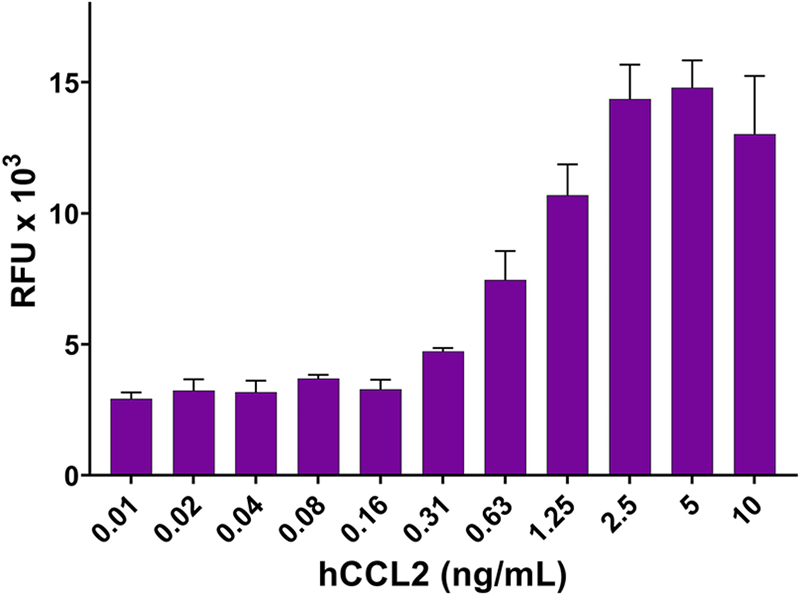
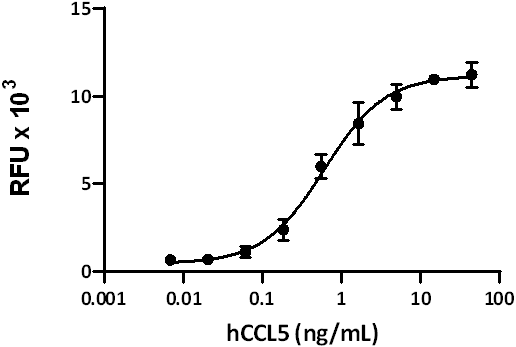
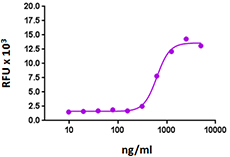
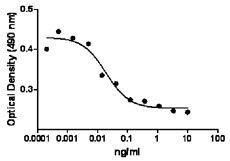





Follow Us